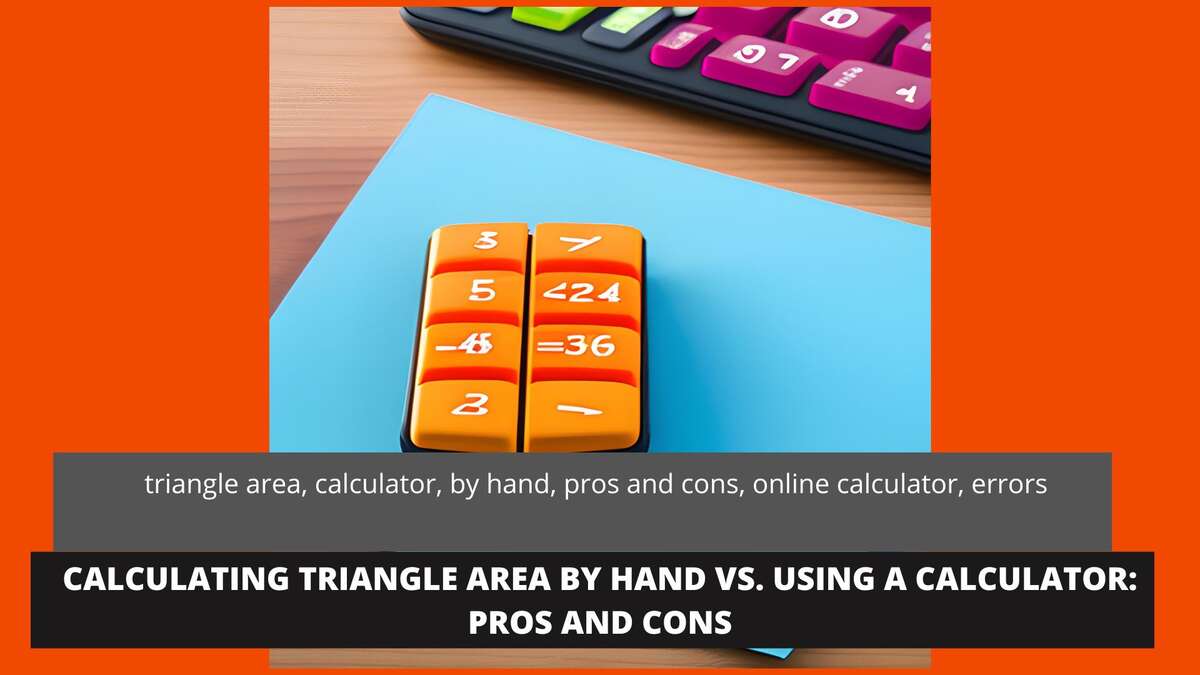Triangles are fundamental geometric shapes used in a wide range of fields, including mathematics, engineering, architecture, and design. One of the most common tasks involving triangles is calculating their area, which can be done either by hand or with the help of an online calculator. In this article, we will explore the pros and cons of each method to help you choose the one that suits your needs.
Calculating Triangle Area by Hand
Calculating triangle area by hand involves using basic geometry formulas to find the area of a given triangle. The most commonly used formula is:
Area = 0.5 × base × height
where the base is the length of the bottom of the triangle, and the height is the distance from the base to the opposite vertex. To calculate the area of a triangle by hand, you will need to measure the base and height of the triangle, multiply them together, and divide the result by two.
Pros of Calculating Triangle Area by Hand
One of the main advantages of calculating triangle area by hand is that it allows you to develop a deeper understanding of geometry and its applications. By doing the calculations manually, you get a better sense of how different variables affect the final result, which can be useful in other areas of mathematics.
Another benefit of calculating triangle area by hand is that it does not require any special tools or equipment. All you need is a ruler, a pencil, and a piece of paper, making it a convenient option for students or professionals who may not have access to calculators or computers.
Cons of Calculating Triangle Area by Hand
One of the biggest drawbacks of calculating triangle area by hand is the potential for human error. Even a small mistake in measuring the base or height of the triangle can lead to significant errors in the final calculation. This can be particularly problematic when dealing with complex triangles, which may require multiple calculations to determine the correct area.
Another disadvantage of calculating triangle area by hand is the amount of time and effort required. While the formula itself is relatively simple, it can be time-consuming to measure the base and height accurately and perform the necessary calculations. This can be especially frustrating for those who need to calculate the area of many triangles in a short amount of time.
Using an Online Calculator to Calculate Triangle Area
Using an online calculator to calculate triangle area involves entering the dimensions of the triangle into a web-based tool that performs the calculations automatically. There are many online calculators available for this purpose, including the one found at https://askmycalculator.com/triangle-area-calculator.
To use the calculator, you simply need to enter the length of the base and the height of the triangle into the appropriate fields and click the "Calculate" button. The calculator will then display the area of the triangle in square units.
Pros of Using an Online Calculator
One of the biggest advantages of using an online calculator to calculate triangle area is its speed and accuracy. The calculator can perform the necessary calculations in a matter of seconds, and it eliminates the potential for human error in the measurement process. This makes it a great option for those who need to calculate the area of many triangles quickly and accurately.
Another benefit of using an online calculator is that it can handle complex triangles with irregular shapes and angles that would be difficult to calculate by hand. This can be particularly useful in fields such as architecture and engineering, where accurate measurements are essential.
Finally, using an online calculator can be a convenient option for those who are not familiar with the geometry formulas or who do not have the time or patience to perform the calculations manually. The calculator does all the work for you, allowing you to focus on other tasks.
Cons of Using an Online Calculator
One potential disadvantage of using an online calculator to calculate triangle area is that it can be less educational than doing the calculations by hand. By relying on the calculator, you may miss out on the opportunity to develop a deeper understanding of geometry and its applications. Additionally, if you are not careful in selecting a reliable calculator, you may end up with inaccurate results.
Another potential drawback of using an online calculator is that it requires access to a computer or smartphone and an internet connection. This can be a limitation for those who do not have reliable access to technology or who prefer to work offline.
Conclusion
Both calculating triangle area by hand and using an online calculator have their advantages and disadvantages. Calculating by hand can help you develop a deeper understanding of geometry and is a convenient option when you don't have access to technology. However, it is time-consuming and prone to human error. On the other hand, using an online calculator is fast, accurate, and convenient, but may be less educational and requires access to technology.
Ultimately, the method you choose will depend on your personal preferences and the nature of your work. If you are a student or professional who needs to calculate the area of many triangles quickly and accurately, an online calculator may be the best option. However, if you are interested in developing a deeper understanding of geometry or prefer to work offline, calculating by hand may be a better choice.
Regardless of which method you choose, it is important to ensure the accuracy of your calculations and to double-check your work to avoid errors. If you do choose to use an online calculator, be sure to select a reliable and trustworthy tool to ensure accurate results.
Overall, the ability to calculate the area of a triangle is an important skill in many fields, and both manual and digital methods have their place in the world of geometry and mathematics.
